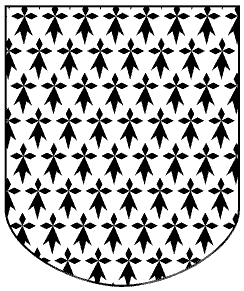Ermine: Difference between revisions
m (Natural history notes) |
m (added png image) |
||
| Line 1: | Line 1: | ||
One of the [[fur]]s used as a [[tincture]] ([[colour]]) in [[heraldry]]. It consists of black (''[[sable]]'') ermine spots on a white (''[[argent]]'') field. |
[[image:ermine.png|thumb|right]]One of the [[fur]]s used as a [[tincture]] ([[colour]]) in [[heraldry]]. It consists of black (''[[sable]]'') ermine spots on a white (''[[argent]]'') field. |
||
The inverse (white on black) is called ''[[counter-ermine]]'' or ''ermines''. |
The inverse (white on black) is called ''[[counter-ermine]]'' or ''ermines''. |
||
[[image:ermine.gif]] |
|||
---- |
---- |
||
Revision as of 04:31, 3 August 2005
One of the furs used as a tincture (colour) in heraldry. It consists of black (sable) ermine spots on a white (argent) field.
The inverse (white on black) is called counter-ermine or ermines.
Natural history
The ermine or short-tailed weasel, whose skins are represented by the heraldic tincture (the black spots representing either the little legs and feet, or the black-ended tail), lives in cold regions of North America and Europe. They measure about 10" plus about a 3" tail. They are yellow-brown most of the year but grow a snow-white coat in winter. Their skins were prized as clothing decoration.
They should not be confused with the similar creature on the Discworld, the vermine, a small black and white relative of the lemming, whose skin is also highly valued, not least by the vermine itself, which will do almost anything to keep possession of it.
